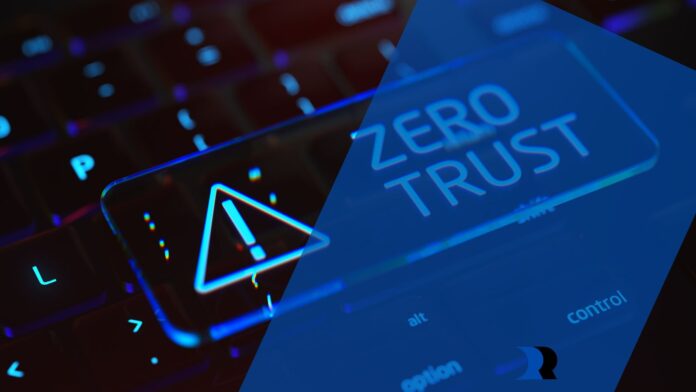Your company is only establishing cyber resilience if it embraces Zero Trust.
Traditional protection measures are no longer enough as cybersecurity threats evolve. With breaches and ransomware attacks inevitable, enterprises must embrace Zero Trust.
This thorough book will explain what creating a Zero Trust architecture means, including its basic philosophy, network design principles, and critical role in data security. In addition, we will look into Zero Trust Segmentation, which is a vital component of any Zero Trust architecture.
What Exactly Is a Zero Trust Architecture?
In contrast to traditional security approaches, which assume implicit confidence inside the network perimeter and skepticism outside of it, Zero confidence implies zero inherent trust—both internally and externally. Every workload, application, user, device, or system that attempts to access resources is rigorously validated, approved, and monitored in real-time.
If there’s one thing that all breaches and ransomware have in common, it’s that they want to travel laterally. A Zero Trust architecture’s primary goal is to reduce the risk of lateral movement and data exfiltration caused by breaches and ransomware attacks.
Zero trust does not believe that movement or exfiltration can be completely avoided. Instead, it implements preventative efforts to thwart and slow down assaults as they occur.
4 Core Zero Trust Architectural Design Concepts
Adopting network design principles and best practices is required while implementing Zero Trust architecture. Let’s look at the important components of a strong zero-trust network:
Least-privilege Access
The idea of least privilege guarantees that users and systems have the access necessary to complete their responsibilities. This reduces the possible effect of security events by limiting the attack surface. Organizations reduce the risk of unwanted access and data breaches by issuing only the required permissions.
Continuous Authentication
Traditional security architectures often require workloads, applications, and users to be authenticated solely at the point of entry. Zero Trust advocates for both external and internal network authentication. This dynamic strategy entails continually evaluating the workload, application’s, or user’s identification and access permissions and altering them in response to real-time changes in behavior, device state, and other contextual circumstances.
Endpoint Trustworthiness
Zero trust investigates the trustworthiness of endpoint devices in addition to user authentication. Device security posture should be evaluated by organizations, taking into account aspects like patch levels, security settings, and compliance with corporate rules. Access is provided only to devices that match preset security rules.
Zero Trust Segmentation (ZTS)
ZTS, also known as micro-segmentation, is a critical component of any zero-trust design. Organizations use ZTS to construct tiny, isolated parts inside the network rather than relying on a monolithic perimeter to safeguard the whole network. Each segment has its own set of security rules in place to limit lateral movement and contain possible breaches. This granular approach improves overall cyber resilience and aids in fulfilling various global security compliance obligations.
The Benefits of Zero Trust Security
The fundamental advantage of a zero trust method is that it protects from all sides – both within and outside the network. Traditional security methods fail enterprises because they rely on network perimeter protection. Many breaches, on the other hand, come from inside the network. It might come directly from workers or external threats infiltrating the network via VPN connections, email, browsers, endpoints, and other sources.
As a result, zero trust security denies access to everyone until the protected network can determine authorized users. It then monitors how users utilize data in real-time and may cancel access to transfer or delete data elsewhere.
IT teams may build zero-trust capabilities into business processes, systems, and services, enabling them to
- Prevent data breaches and employ application micro-segmentation to limit lateral movement.
- Increase security protection across computing and containerized environments while completely independent of the underlying infrastructure.
- Constantly monitor for and react to threats or indicators of compromise. It records, reports, alerts to risks, and responds appropriately.
- Gain insight into people, components, devices, and workloads, and discover and enforce regulations.
- Ensure the security of the enterprise while offering a uniform user experience.
- Reduce the number of full-time equivalent hours and the architectural complications.
A Zero trust security model can expedite user access, simplify IT administration, optimize for current IT and security professionals, safeguard distant workforces, maintain continual compliance, and provide senior management with peace of mind.
8 Steps to Establishing a Zero Trust Architecture
Adopting a Zero Trust architecture requires a systematic and gradual approach. Here are the important measures enterprises should take to effectively deploy Zero Trust, as well as how Illumio ZTS can assist:
Identify the Data
To begin your Zero Trust journey, you must determine what you must safeguard. Take an inventory to get awareness of where and what your sensitive data is located.
Discover Traffic
You can’t safeguard what you can’t see. The application dependency map in Illumio ZTS may provide comprehensive, real-time insight into traffic flows between apps and application dependencies, allowing you to understand your organization’s threat surface better.

Ensure that your visibility reflects network changes, particularly the fast-paced changes in the cloud, so you have an accurate image of the network in real-time.
Define Security Policy
Observing network traffic flows will aid you in developing a Zero Trust architecture with default-deny security policies. Illumio ZTS can assist you in automatically generating the best policy for each application and identifying high-risk or wasteful traffic flows.
Encrypt In-transit Data
Encrypting data in transit across all environments is a critical component of any Zero Trust architecture, in addition to meeting numerous legal requirements. Illumio ZTS provides in-transit data encryption at the individual task level using Illumio SecureConnect, which uses the IPSec encryption libraries in all contemporary operating systems.
Test
Testing your new Zero Trust security rules is an important element of the process since it allows you to simulate how policies will affect the network without committing to full enforcement. Security teams may use Illumio’s simulation mode to guarantee policy execution is less risky, has fewer misconfigurations, and does not cause network outages or availability issues.
Enforce
After verifying the policies in simulation mode, it is time to implement them fully. Using Illumio, you may get warnings and useful, contextual data and maintain complete visibility throughout the application’s lifetime.
Monitor and Maintain
Keeping and sustaining corporate security and implementation needs ongoing effort and attention.

Remember that Zero Trust architecture is a framework and process, not a technology. With what you’ve learned, you can apply Zero Trust Segmentation to each new application in your organization and gradually discover the ideal process while adhering to a never trust, always verify strategy.
Embrace Automation and Orchestration
Managing today’s complex, ever-changing networks necessitates using automation and orchestration by security teams. Teams can better manage a stable, predictable, and dependable network with the help of these new technologies.
Conclusion
Traditional “trust but verify” network cybersecurity tactics are insufficient to thwart attacks and secure data and systems as cyberattacks against enterprises expand and adapt. Implicitly trusting endpoints, devices, and users inside their network exposes the business to hostile actors, unauthorized users, hacked accounts, and irresponsible insiders.
As a result, a zero-trust security paradigm is crucial to the organization’s security. The security strategy of “never trust, always verify,” as well as the concepts of least privilege and micro-segmentation, give stronger protection against the ever-changing and developing cyber threat environment.
Zero trust enables enterprises to improve access control, limit breaches, secure assets, and minimize the risk of harm. However, all this labor and money might be well-spent with a well-planned design and strategy.


